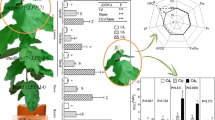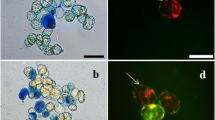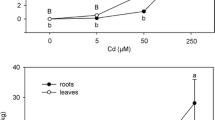Abstract
Selection of poplar species with greater Cd tolerance and exploiting the physiological mechanisms involved in Cd tolerance are crucial for application of these species to phyto-remediation. The aim of this study is to investigate variation in Cd tolerance among the six poplar species and its underlying physiological mechanisms. Cuttings of six Populus species were cultivated for 10 weeks before exposure to either 0 or 200 μM CdSO4 for 20 days. Gas exchange in mature leaves was determined by a portable photosynthesis system. Cd concentrations in tissues were analyzed by a flame atomic absorbance spectrometry. Subsequently, Cd amount per plant, bio-concentration factor (BCF) and translocation factor (T f) were calculated. Nonenzymatic compounds and activities of antioxidative enzymes in tissues were analyzed spectrophotometrically. Cd exposure caused decline in photosynthesis in four poplar species including Populus cathayana (zhonghua 1). Among the six species, P. cathayana (zhonghua 1) displayed the highest Cd concentrations in tissues, the largest Cd amount in aerial parts, the highest BCF in aerial parts and T f under Cd exposure. Under Cd stress, increases in total soluble sugars in roots but decreases in starch in roots, wood, and leaves of P. cathayana (zhonghua 1) were found. Induced O •−2 and H2O2 production in roots and leaves, and increases in free proline, soluble phenolics, and activities of antioxidative enzymes were observed in P. cathayana (zhonghua 1). Based on results of this pot experiment, it is concluded that P. cathayana (zhonghua 1) is superior to other five species for Cd phyto-remediation, and its well-coordinated physiological changes under Cd exposure confer the great Cd tolerance of this species.






Similar content being viewed by others
References
Bi YH, Chen WL, Zhang WN, Zhou Q, Yun LJ, Xing D (2009) Production of reactive oxygen species, impairment of photosynthetic function and dynamic changes in mitochondria are early events in cadmium-induced cell death in Arabidopsis thaliana. Biol Cell 101:629–643
Cao X, Jia J, Li H, Li M, Luo J, Liang Z, Liu T, Liu W, Peng C, Luo Z-B (2012) Photosynthesis, water use efficiency and stable carbon isotope composition are associated with anatomical properties of leaf and xylem in six poplar species. Plant Biol. doi:10.1111/j.1438-8677.2011.00531.x
Castiglione S, Todeschini V, Franchin C, Torrigiani P, Gastaldi D, Cicatelli A, Rinaudo C, Berta G, Biondi S, Lingua G (2009) Clonal differences in survival capacity, copper and zinc accumulation, and correlation with leaf polyamine levels in poplar: A large-scale field trial on heavily polluted soil. Environ Pollut 157:2108–2117
Di Lonardo S, Capuana M, Arnetoli M, Gabbrielli R, Gonnelli C (2011) Exploring the metal phytoremediation potential of three Populus alba L. clones using an in vitro screening. Environ Sci Pollut Res 18:82–90
Durand TC, Sergeant K, Planchon S, Carpin S, Label P, Morabito D, Hausman JF, Renaut J (2010) Acute metal stress in Populus tremula × P. alba (717-1B4 genotype): Leaf and cambial proteome changes induced by cadmium2+. Proteomics 10:349–368
Elobeid M, Göbel C, Feussner I, Polle A (2012) Cadmium interferes with auxin physiology and lignification in poplar. J Exp Bot. doi:10.1093/jxb/err384
Fischerova Z, Tlustos P, Szakova J, Sichorova K (2006) A comparison of phytoremediation capability of selected plant species for given trace elements. Environ Pollut 144:93–100
Grace S (2005) Phenolics as antioxidants. In: Smirnoff N (ed) Antioxidants and reactive oxygens pecies. Blackwell, London, pp 141–168
Gratao PL, Polle A, Lea PJ, Azevedo RA (2005) Making the life of heavy metal-stressed plants a little easier. Funct Plant Biol 32:481–494
Hall JL (2002) Cellular mechanisms for heavy metal detoxification and tolerance. J Exp Bot 53:1–11
Hanikenne M, Nouet C (2011) Metal hyperaccumulation and hypertolerance: a model for plant evolutionary genomics. Curr Opin Plant Biol 14:252–259
He J, Qin J, Long L, Ma Y, Li H, Li K, Jiang X, Liu T, Polle A, Liang Z, Luo Z-B (2011) Net cadmium flux and accumulation reveal tissue-specific oxidative stress and detoxification in Populus × canescens. Physiol Plant 143:50–63
Hermans C, Chen JG, Coppens F, Inze D, Verbruggen N (2011) Low magnesium status in plants enhances tolerance to cadmium exposure. New Phytol 192:428–436
Heyno E, Klose C, Krieger-Liszkay A (2008) Origin of cadmium-induced reactive oxygen species production: mitochondrial electron transfer versus plasma membrane NADPH oxidase. New Phytol 179:687–699
Kaplan O, Ince M, Yaman M (2011) Sequential extraction of cadmium in different soil phases and plant parts from a former industrialized area. Environ Chem Lett 9:397–404
Kieffer P, Dommes J, Hoffmann L, Hausman JF, Renaut J (2008) Quantitative changes in protein expression of cadmium-exposed poplar plants. Proteomics 8:2514–2530
Kieffer P, Planchon S, Oufir M, Ziebel J, Dommes J, Hoffmann L, Hausman JF, Renaut J (2009) Combining proteomics and metabolite analyses to unravel cadmium stress-response in poplar leaves. J Proteome Res 8:400–417
Kramer U (2005) Phytoremediation: novel approaches to cleaning up polluted soils. Curr Opin Biotechnol 16:133–141
Kramer U (2010) Metal hyperaccumulation in plants. Annu Rev Plant Biol 61:517–534
Laureysens I, Blust R, De Temmerman L, Lemmens C, Ceulemans R (2004) Clonal variation in heavy metal accumulation and biomass production in a poplar coppice culture: I. Seasonal variation in leaf, wood and bark concentrations. Environ Pollut 131:485–494
Laureysens I, De Temmerman L, Hastir T, Van Gysel M, Ceulemans R (2005) Clonal variation in heavy metal accumulation and biomass production in a poplar coppice culture. II. Vertical distribution and phytoextraction potential. Environ Pollut 133:541–551
Lei YB, Korpelainen H, Li CY (2007) Physiological and biochemical responses to high Mn concentrations in two contrasting Populus cathayana populations. Chemosphere 68:686–694
Lu LL, Tian SK, Yang XE, Wang XC, Brown P, Li TQ, He ZL (2008) Enhanced root-to-shoot translocation of cadmium in the hyperaccumulating ecotype of Sedum alfredii. J Exp Bot 59:3203–3213
Luo ZB, Calfapietra C, Scarascia-Mugnozza G, Liberloo M, Polle A (2008) Carbon-based secondary metabolites and internal nitrogen pools in Populus nigra under free air CO2 enrichment (FACE) and nitrogen fertilisation. Plant Soil 304:45–57
Ma FW, Cheng LL (2003) The sun-exposed peel of apple fruit has higher xanthophyll cycle-dependent thermal dissipation and antioxidants of the ascorbate-glutathione pathway than the shaded peel. Plant Sci 165:819–827
Marmiroli M, Visioli G, Maestri E, Marmiroli N (2011) Correlating SNP genotype with the phenotypic response to exposure to cadmium in Populus spp. Environ Sci Technol 45:4497–4505
Meighan MM, Fenus T, Karey E, MacNeil J (2011) The impact of EDTA on the rate of accumulation and root/shoot partitioning of cadmium in mature dwarf sunflowers. Chemosphere 83:1539–1545
Milner MJ, Kochian LV (2008) Investigating heavy-metal hyperaccumulation using Thlaspi caerulescens as a model system. Ann Bot 102:3–13
Morel FMM (2008) The co-evolution of phytoplankton and trace element cycles in the oceans. Geobiology 6:318–324
Najeeb U, Jilani G, Ali S, Sarwar M, Xu L, Zhou WJ (2011) Insights into cadmium induced physiological and ultra-structural disorders in juncus effusus L. and its remediation through exogenous citric acid. J Hazard Mater 186:565–574
Pandhair V, Sekhon BS (2006) Reactive oxygen species and antioxidants in plants: an overview. J Plant Biochem Biot 15:71–78
Pietrini F, Zacchini M, Iori V, Pietrosanti L, Bianconi D, Massacci A (2010) Screening of poplar clones for cadmium phytoremediation using photosynthesis, biomass and cadmium content analyses. Int J Phytoremediat 12:105–120
Polle A, Douglas C (2010) The molecular physiology of poplars: paving the way for knowledge-based biomass production. Plant Biol 12:239–241
Polle A, Chakrabarti K, Schurmann W, Renneberg H (1990) Composition and properties of hydrogen peroxide decomposing systems in extracellular and total extracts from needles of Norway spruce (Picea abies L., Karst.). Plant Physiol 94:312–319
Polle A, Klein T, Kettner C (2012) Impact of cadmium on young plants of Populus euphratica and P. × canescens, two poplar species that differ in stress tolerance. New For. doi:10.1007/s11056-011-9301-9
Rodriguez-Serrano M, Romero-Puertas MC, Sparkes I, Hawes C, del Rio LA, Sandalio LM (2009) Peroxisome dynamics in Arabidopsis plants under oxidative stress induced by cadmium. Free Radic Biol Med 47:1632–1639
Schützendübel A, Polle A (2002) Plant responses to abiotic stresses: heavy metal-induced oxidative stress and protection by mycorrhization. J Exp Bot 53:1351–1365
Schützendübel A, Nikolova P, Rudolf C, Polle A (2002) Cadmium and H2O2-induced oxidative stress in Populus × canescens roots. Plant Physiol Bioch 40:577–584
Shi GR, Cai QS (2009) Cadmium tolerance and accumulation in eight potential energy crops. Biotechnol Adv 27:555–561
Shi GR, Liu CF, Cai QS, Liu QQ, Hou CP (2010) Cadmium accumulation and tolerance of wwo safflower cultivars in relation to photosynthesis and antioxidantive enzymes. Bull Environ Contam Toxicol 85:256–263
Sun YB, Zhou QX, Wang L, Liu WT (2009) Cadmium tolerance and accumulation characteristics of Bidens pilosa L. as a potential Cd-hyperaccumulator. J Hazard Mater 161:808–814
Tamas L, Bocova B, Huttova J, Mistrik I, Olle M (2006) Cadmium-induced inhibition of apoplastic ascorbate oxidase in barley roots. Plant Growth Regul 48:41–49
Tamas L, Dudikova J, Durcekova K, Halugkova L, Huttova J, Mistrik I, Olle M (2008) Alterations of the gene expression, lipid peroxidation, proline and thiol content along the barley root exposed to cadmium. J Plant Physiol 165:1193–1203
Unterbrunner R, Puschenreiter M, Sommer P, Wieshammer G, Tlustos P, Zupan M, Wenzel WW (2007) Heavy metal accumulation in trees growing on contaminated sites in Central Europe. Environ Pollut 148:107–114
Vangronsveld J, Herzig R, Weyens N, Boulet J, Adriaensen K, Ruttens A, Thewys T, Vassilev A, Meers E, Nehnevajova E, van der Lelie D, Mench M (2009) Phytoremediation of contaminated soils and groundwater: lessons from the field. Environ Sci Pollut Res 16:765–794
Wu FZ, Yang WQ, Zhang J, Zhou LQ (2010) Cadmium accumulation and growth responses of a poplar (Populus deltoids × Populus nigra) in cadmium contaminated purple soil and alluvial soil. J Hazard Mater 177:268–273
Yadav R, Arora P, Kumar S, Chaudhury A (2010) Perspectives for genetic engineering of poplars for enhanced phytoremediation abilities. Ecotoxicology 19:1574–1588
Yaman M (2006) Comprehensive comparison of trace metal concentrations in cancerous and non-cancerous human tissues. Curr Med Chem 13:2513–2525
Yemm EW, Willis AJ (1954) The estimation of carbohydrates in plant extracts by anthrone. Biochem J 57:508–514
Zacchini M, Pietrini F, Scarascia-Mugnozza G, Iori V, Pietrosanti L, Massacci A (2009) Metal tolerance, accumulation and translocation in poplar and willow clones treated with cadmium in hydroponics. Water Air Soil Pollut 197:23–34
Zacchini M, Iori V, Scarascia-Mugnozza G, Pietrini F, Massacci A (2011) Cadmium accumulation and tolerance in Populus nigra and Salix alba. Biol Plant 55:383–386
Zhao FJ, McGrath SP (2009) Biofortification and phytoremediation. Curr Opin Plant Biol 12:373–380
Acknowledgments
This work was supported by the Special Fund for Forest Science and Technology Research in the Public Interest (grant no. 201204210), the State Key Basic Research Development Program (grant no. 2012CB416902), the National Natural Science Foundation of China (grant no. 31070539 and 31100481), the Program for New Century Excellent Talents in University from the Ministry of Education of China (grant no. NCET-08-0468), the Fok Ying Tung Education Foundation (grant no. 121026), the Specialized Research Fund for the Doctoral Program of Higher Education of China (grant no. 20090204110027), the Fundamental Research Funds for the Central Universities of China (grant no. QN2009063).
Author information
Authors and Affiliations
Corresponding author
Additional information
Responsible editor: Elena Maestri
Electronic supplementary material
Below is the link to the electronic supplementary material.
ESM 1
(XLS 709 kb)
Rights and permissions
About this article
Cite this article
He, J., Ma, C., Ma, Y. et al. Cadmium tolerance in six poplar species. Environ Sci Pollut Res 20, 163–174 (2013). https://doi.org/10.1007/s11356-012-1008-8
Received:
Accepted:
Published:
Issue Date:
DOI: https://doi.org/10.1007/s11356-012-1008-8




